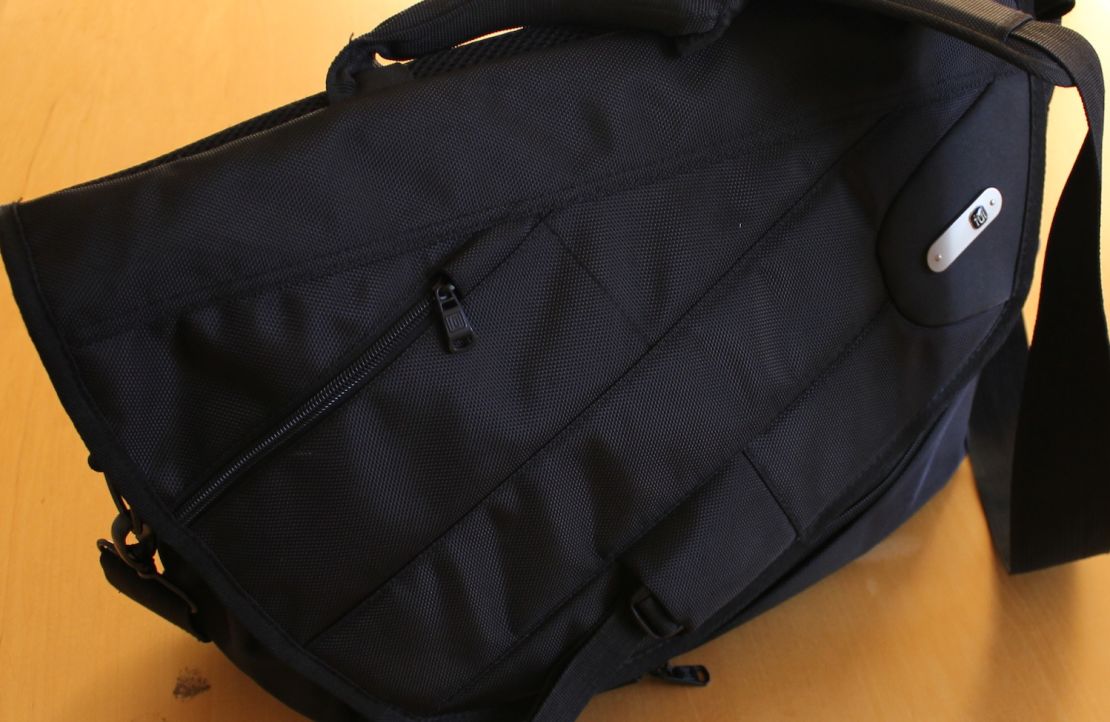Story highlights
We review Powerbag, a line of battery-equipped shoulder bags and backpacks
A full battery charge can fill up about two smartphones
Unlike solar-powered bags, you can hardly tell it's a geek accessory
Powerbag spokesman: The battery was rigorously tested for safety
Thanks to a wave of new mobile technology, I can store my calendar, car keys, credit cards, music and notes all on my smartphone.
That kind of convergence is convenient, but my phone has an Achilles’ heel. The battery doesn’t last forever.
Enter the Powerbag, a line of battery-equipped shoulder bags and backpacks made by RFA Brands. It’s a smart backup for when gadgets inevitably need to take naps.
I tested the Powerbag messenger bag for about a month, and I also spent a brief time using the backpack, which is very similar. On several instances during my tests, the bag proved useful on long trips or when traveling to conferences where I’m constantly making calls or doing e-mail.
Gadget Review: Powerbag Messenger
Features: Rechargeable battery connected to standard-size cords for iPod, BlackBerry and other gadgets
Price: $140
Our Verdict: A handy, stylish bag for gadget lovers who don’t want to advertise their geekiness
I had to overcome a couple of concerns before strapping on the Powerbag. For one, the idea of carrying a battery about the size of a deck of cards on my back in the rain is not comforting.
And this line in the Powerbag manual’s lengthy “warnings” section is not exactly reassuring: “Improper use of this product may result in product damage, excess heat, toxic fumes, fire or explosion.”
“Powerbag sources the highest quality cells and parts for the batteries,” a Ful spokesman wrote in a reply to my worried e-mail. “Our batteries are all rigorously and thoroughly tested, enduring the most abusive of treatment, still upholding Powerbag’s high standard of safety.”
When I considered that I keep my phone in my pocket near vital organs, the fear seemed less rational. The battery is stored in a zippered pocket at the bottom of the bag. I wouldn’t take the bag on a whitewater canoe trip or a daylong hike under the blistering Egyptian sun, but the rain didn’t faze it.
My other hangup involved the annoyance of having one more thing to keep charged. I already charge my smartphone, tablet, laptop, iPod, computer mouse and Bluetooth headset. Now I need to charge my shoulder bag, too?
However, I was pleasantly surprised by how long the Powerbag’s battery lasts. It went for more than a week at a time retaining most of its charge. On a single charge, it can completely fill about two small gadgets – a phone and iPod, for example.
The bag includes three standard-size cords, including one that works with iPhones and iPods, and another that charges BlackBerrys, Mi-Fis and many Android phones. An iPod can be tucked into one zippered pocket while a BlackBerry can go into another, each filling with juice simultaneously.

The Powerbag is able to charge an iPad, which is nice because many alarm clocks tailored to iPods and iPhones cannot. But the tablet’s big battery sucks power more quickly, and it can’t be fit securely anywhere for charging on the go.
I was disappointed to learn that the Powerbag doesn’t provide an easy way to charge a laptop, which would have been useful for just a few more minutes of work on Wi-Fi at a coffee shop.
A standard USB port is hidden in the battery pouch, so perhaps buying a USB-to-laptop charging cord would do the trick. An RFA Brands spokesman said that including a two- or three-prong outlet would require the bag to have a cooling system, which is something the company is not eager to do.
There’s a conspicuous button on the front of the bag for checking the battery’s charge status: up to four small lights, which can be hard to see in daylight.
I kept the bag’s charger tucked in a pouch inside the bag. The cap and charging port located on the side of the bag snapped off a few days after I started testing it, and so from then on, I had to take the battery out and plug the cord in directly whenever I needed to refuel.
The RFA spokesman said this was only an issue with pre-production models, like the one I tested, and that it’s been fixed for the bags sold in stores. The Messenger Powerbag costs about $140, same as the backpack, and is sold at some big electronics and office supply stores, including Best Buy and Office Max. RFA also produces bags with bigger batteries for about $40 more.
There are several other travel bags on the market that have batteries inside, including ones that can be charged by sunlight using solar panels on the exterior.
But most solar-powered bags look like an accessory that would have gotten a kid beat up in school. The Powerbag, designed by Ful, is stylish as well as useful, making it a good companion for gadgetheads who don’t want to advertise their geekiness.




